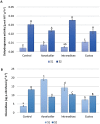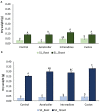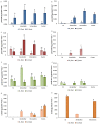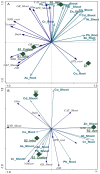Inoculation of Indigenous Arbuscular Mycorrhizal Fungi as a Strategy for the Recovery of Long-Term Heavy Metal-Contaminated Soils in a Mine-Spill Area
- PMID: 36675877
- PMCID: PMC9861793
- DOI: 10.3390/jof9010056
Inoculation of Indigenous Arbuscular Mycorrhizal Fungi as a Strategy for the Recovery of Long-Term Heavy Metal-Contaminated Soils in a Mine-Spill Area
Abstract
Symbiotic associations with arbuscular mycorrhizal fungi (AMF) offer an effective indirect mechanism to reduce heavy metal (HM) stress; however, it is still not clear which AMF species are more efficient as bioremediating agents. We selected different species of AMF: Rhizoglomus custos (Custos); Rhizoglomus sp. (Aznalcollar); and Rhizophagus irregularis (Intraradices), in order to study their inoculation in wheat grown in two soils contaminated with two levels of HMs; we tested the phytoprotection potential of the different AMF symbioses, as well as the physiological responses of the plants to HM stress. Plants inoculated with indigenous Aznalcollar fungus exhibited higher levels of accumulation, mainly in the shoots of most of the HM analyzed in heavily contaminated soil. However, the plants inoculated with the non-indigenous Custos and Intraradices showed depletion of some of the HM. In the less-contaminated soil, the Custos and Intraradices fungi exhibited the greatest bioaccumulation capacity. Interestingly, soil enzymatic activity and the enzymatic antioxidant systems of the plant increased in all AMF treatments tested in the soils with both degrees of contamination. Our results highlight the different AMF strategies with similar effectiveness, whereby Aznalcollar improves phytoremediation, while both Custos and Intraradices enhance the bioprotection of wheat in HM-contaminated environments.
Keywords: arbuscular mycorrhizas; heavy metals; indigenous fungi; metal tolerance; phytoremediation; soil pollution.
Conflict of interest statement
The authors declare no conflict of interest.
Figures






References
-
- Ali H., Khan E., Ilahi I. Environmental chemistry and ecotoxicology of hazardous heavy metals: Environmental Persistence, Toxicity, and Bioaccumulation. J. Chem. 2019:6730305. doi: 10.1155/2019/6730305. - DOI
-
- Sun Y., Yu I.K.M., Tsang D.C.W., Cao X., Lin D., Wang L., Graham N.J.D., Alessi D.S., Komárek M., Ok Y.S., et al. Multifunctional Iron-Biochar Composites for the Removal of Potentially Toxic Elements, Inherent Cations, and Hetero-Chloride from Hydraulic Fracturing Wastewater. Environ. Int. 2019;124:521–532. doi: 10.1016/j.envint.2019.01.047. - DOI - PubMed
-
- Yang X., Tsibart A., Nam H., Hur J., El-Naggar A., Tack F.M.G., Wang C.-H., Lee Y.H., Tsang D.C.W., Ok Y.S. Effect of Gasification Biochar Application on Soil Quality: Trace Metal Behavior, Microbial Community, and Soil Dissolved Organic Matter. J. Hazard. Mater. 2019;365:684–694. doi: 10.1016/j.jhazmat.2018.11.042. - DOI - PubMed
LinkOut - more resources
Full Text Sources

